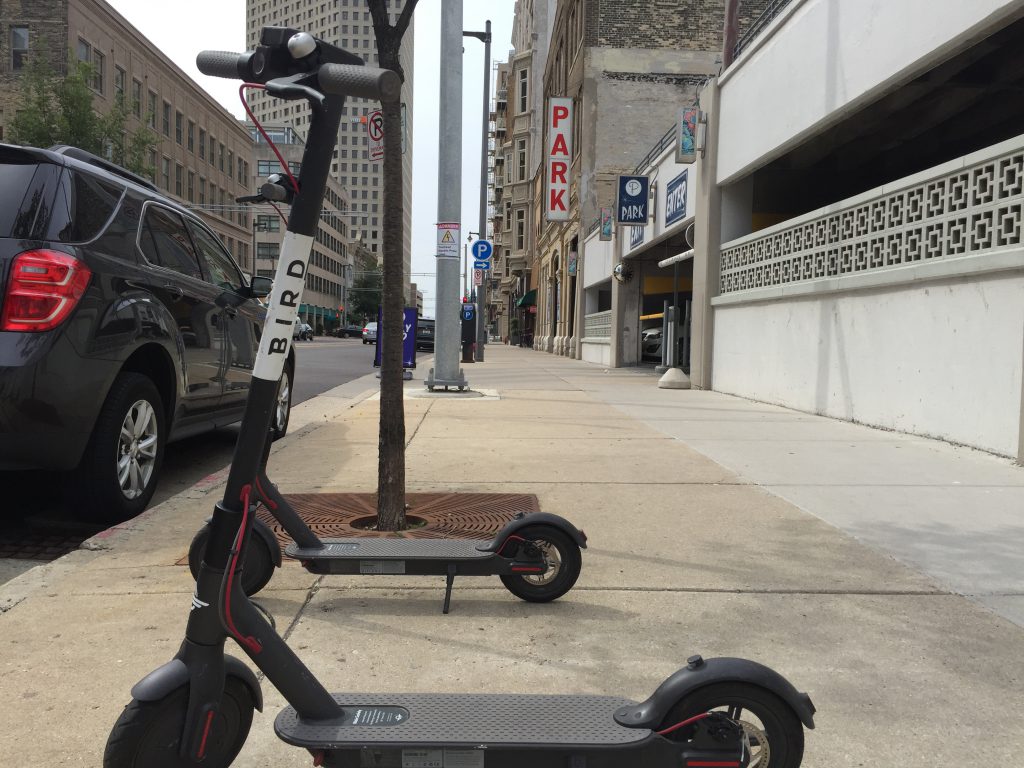Scooters Set For August Return
Council poised to approve new "study" on Tuesday, which would last through 2023.
Dockless electric scooters are poised to return to Milwaukee in August.
That’s according to Department of Public Works representatives who presented a framework Monday for a third “pilot study” that would temporarily authorize the vehicles.
The Public Works Committee unanimously recommended the study’s adoption on a 3-0 vote. The full council is scheduled to consider the proposal at its June 21 meeting.
Participants in the prior scooter deployments included Spin, Bird and Lime. DPW would again allow three companies into the market, through a request-for-proposals process. The companies would be required to equitably distribute their scooters in seven zones across the city at the start of each day and face a cap on the maximum number of scooters that could be deployed.
The latest “study” would impose a $0.25-per-trip fee, $25-per-incident relocation fee and a $50-per-scooter fee. The fees are to be used to monitor and administer the pilot, which in 2021 included a third-party tracking illegal sidewalk riding, and to improve bicycling and scooter infrastructure.
Unlike the 2021 study, the 2022-2023 study, as currently proposed, does not include an automatic trigger to ban greater downtown area usage if a consultant determines more than 10% of riders are improperly using the sidewalk to ride. DPW representatives said that geofencing could be used to limit speeds for vehicles that GPS technology indicates are on a sidewalk. Such geofencing is already used to prohibit riverwalk riding and ending a ride in certain areas.
The total number of rides would have been higher, but a ban on scooters in the greater downtown area went into effect on Aug. 3.
The average ride time was 10 minutes, with an average distance of 0.9 miles. Each individual scooter, rentable with a smartphone application, was used an average of 2.6 times per day. The companies were each allowed to deploy up to 1,000 scooters in the city.
There were 15 scooter crashes reported to the Milwaukee Police Department, the majority of which occurred in an area bounded by W. Locust St. and W. Lisbon Ave., between I-43 and N. Sherman Blvd. None were reported Downtown or on the Lower East Side. In one of the crashes, one rider ran into another head on. At least two crashes occurred because riders were improperly using the sidewalk then re-entering the street. Many crashes, based on one-sentence descriptions, were the fault of motorists.
Scooters haven’t been entirely absent from Milwaukee this year. A growing number of people purchased their own scooter and use it much like a bicycle.
An online survey circulated by DPW, and reshared by the media and the scooter companies, yielded 5,428 responses, of which 49.4% were from people who had never ridden a scooter.
The biggest concern of non-riding respondents was sidewalk riding. For those who had taken at least one scooter trip, the greatest concern was there isn’t a safe, connected network of trails and bicycle infrastructure to ride in.
The survey revealed that the most common reason for taking a trip was going to or from an entertainment destination or event (33.5%). Scooters most commonly replaced walking (39%), driving a personal vehicle (24.2%) or taking a taxi or transportation network company vehicle (23.2%). Respondents said 11.4% of trips replaced a public transit or bike trip.
Bird relied on a GPS-based technology. Approximately half of its scooters had the technology by fall 2021, with scooters eventually stopping if sidewalk riding continued on a trip.
Lime used GPS location data mixed with vibration data to warn riders who spent more than 50% of a trip on the sidewalk that a fine of $10 could be issued. No fines were issued, though the technology was integrated into every scooter it offered.
Spin used a camera mounted on 100 of its scooters to detect sidewalk riding, with an audio alarm that went off until a rider returned to the street.
The city installed 58 on-street parking corrals for scooters primarily in areas just north or south of Downtown. They were funded with money from the city’s $65,000 settlement with Bird regarding its unauthorized 2018 deployment of scooters. The on-street corrals are intended to reduce situations where scooters are obstructing sidewalks when parked, a concern that increased in 2021, according to a survey.
Transportation
-
MCTS Adds 28 New Buses
 Jul 13th, 2024 by Graham Kilmer
Jul 13th, 2024 by Graham Kilmer
-
MCTS Designing New Bus Shelters
 Jul 10th, 2024 by Graham Kilmer
Jul 10th, 2024 by Graham Kilmer
-
MCTS Updates RNC Bus Detours To Better Serve Downtown, Riders
 Jul 9th, 2024 by Jeramey Jannene
Jul 9th, 2024 by Jeramey Jannene





















